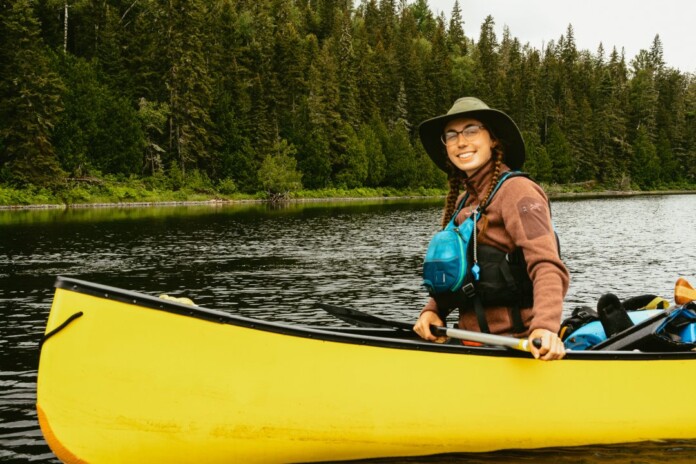Canada is a prime destination for canoe camping, with a nearly endless list of possible destinations. I’ve been canoeing all my life and still feel I have only scratched the surface. But if you’ve never been on a canoe trip before, getting started can feel pretty intimidating. Where do you go? What do you pack? Will there be bears?
In this post, I’m going to outline everything you need to know to plan your first canoe trip. From choosing a destination to packing your gear to execution – this guide will have you ready to hit the water and get paddling.
Pre-Trip Planning
Choosing Your Destination
As I said, the list of destinations is practically endless. So where do you start?
If you’re new to canoe camping, you want to choose a destination that is somewhat popular and isn’t too far away, and an added bonus would be somewhere with developed facilities, like clearly marked campsites and thunder boxes.
I recommend new canoeists choose a national or provincial park. For example, if you are in Ontario I recommend either Algonquin Provincial Park or Killarney Provincial Park because they are easily accessible, fairly popular and have outfitters who set you up with gear. If you’re outside Ontario, you can find good destinations by asking your local MEC or REI (or another outdoor store in your area).
Do you need a reservation or permits? A lot of these destinations will require you to register for campgrounds or obtain a permit, which can usually be done through the park’s website or an outfitter. If all you need is a permit to be in the park, you can do this before finalizing your route (see next section).
However, some parks (like Killarney and Algonquin) require you to book specific campsites. In this case, before you can book your trip you will need to plan your route.
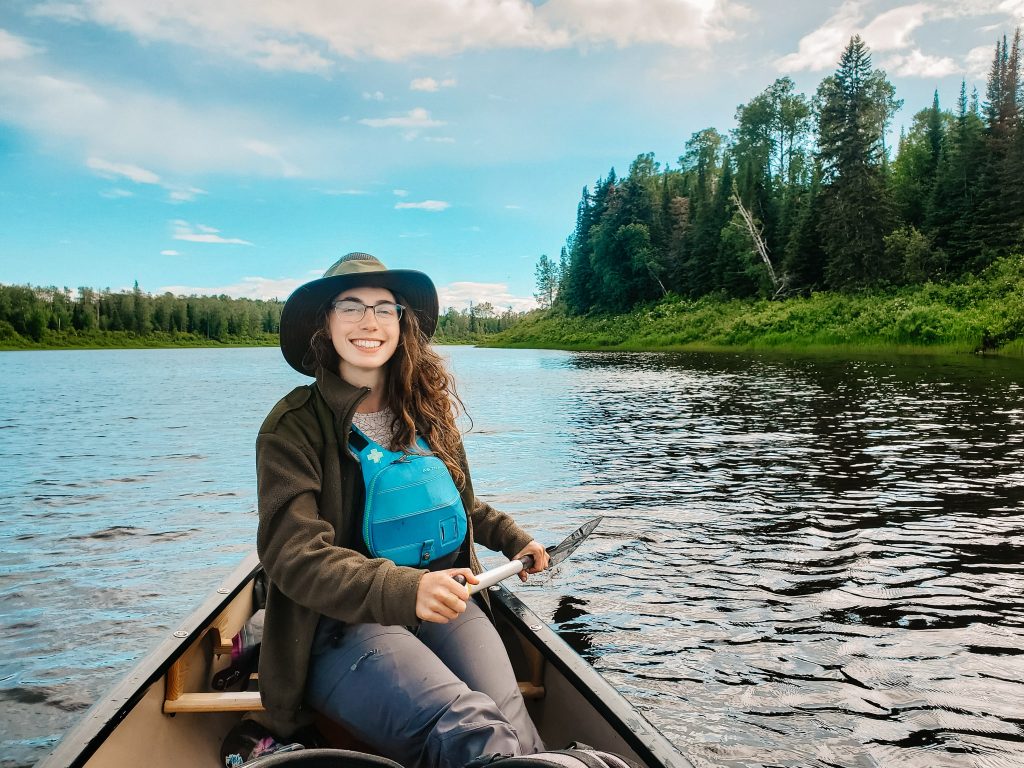
This post may contain affiliate links. If you make a purchase through one of these links, I may receive a small commission at no extra cost to you. Your support is much appreciated! You can learn more by reading my full disclosure.
Planning your Route
Planning your route can be challenging, especially if you are not experienced. For new canoeists, I estimate a paddling speed of 3.5 km per hour and I recommend keeping portages under 400 m.
Pro tip: Don’t plan to be paddling for a full 8 hours each day – that isn’t an enjoyable way get started canoe camping. Keep the trip easy so you can focus on other skills (cooking, setting up a tent) in addition to paddling. Also, you will likely overestimate your speed, so plan on only paddling 4-5 hours per day.
How long should you be out? For your first few trips, I think 1-3 nights is a good length of trip.
Once you have a rough idea of how many kilometres you want to paddle each day, as well as the length of the trip, you can choose your route. There are a few different strategies I suggest to new canoeists.
- Call the park’s outfitter (i.e. Algonquin Outfitters) and ask them what they think. The guides are extremely knowledgable and will be able to help you choose a route that matches your abilities.
- Purchase a park map that shows campsite location, portage lengths and distances between campsites (i.e. Jeff’s Maps). If you call the outfitter, they can help you find the best maps for your trip
- Go to the park’s online reservation system and look at where the campgrounds are located.
- Google something along the lines of “Easy 3 day Algonquin canoe routes”. I feel this is less effective than calling the outfitter directly, but is also an option,
Regardless of how you choose your route, ensure you know where you will need to pick up equipment and leave your car while you’re canoe camping.
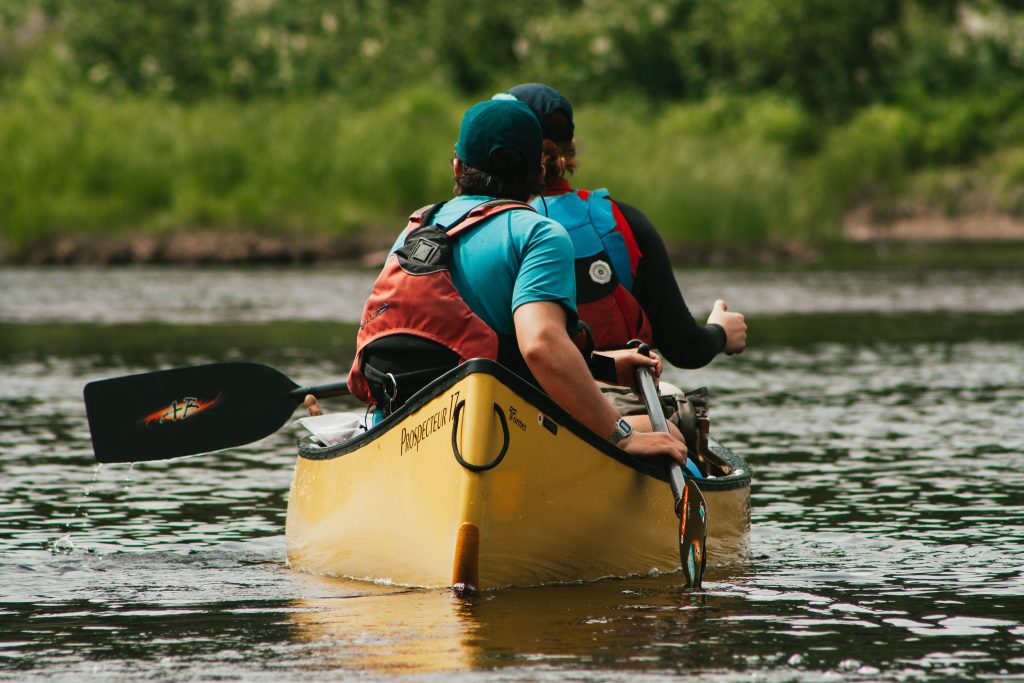
Pre-Trip Packing
Unless you have your own equipment, contact an outfitter about getting the gear you need. Many provincial and national parks have outfitters which service the park, or you can buy/rent gear from a place like Mountain Equipment Co-op. Here’s a fairly comprehensive list of what you’ll need for a canoe trip.
What You Will Put Everything In
In a moment I’m going to list off a lot of equipment for you to bring on your canoe trip. Before we get into all that, let’s talk about what you will put all the equipment in.
Dry Sacks: Dry sacks are bags that keep your stuff dry. You can get them as small as 5 L and as long as 50 L (the large ones often have backpack straps). I recommend going with the brand SealLine (best quality) and ordering from Altitude Sports because they’re often on sale.
Backpacks: Some people put all their personal things in small dry sacks, and then put all the dry sacks in a hiking backpack. I don’t personally do this, though some of the guides I work with swear by it. You can also get large canvas backpacks for the equipment that doesn’t need to stay dry (pots, pans, utensils, tarp). I’ve done this for canoe guiding with camps, though I now prefer to use barrels.
Barrels: I love barrels. They aren’t quite bear proof, but they are rodent proof and water proof and the large top opening makes it easy to find things inside. They are primarily used for food, but I like using them for all my gear. I will put my things in smaller bags to keep everything organized inside.
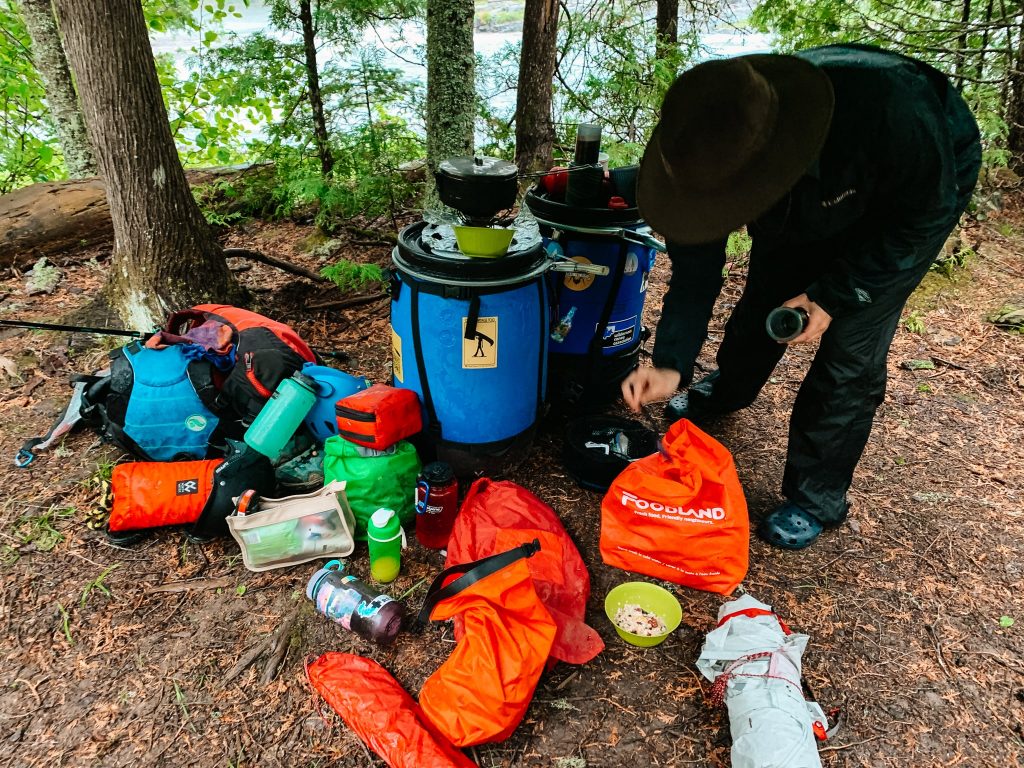
Paddling Equipment
All of the paddling equipment can be easily rented from the park’s outfitter.
Canoe: 1 per two people paddling (you can do three in a boat, but it makes the canoe more wobbly and is uncomfortable for the middle person). Wherever you’re going, you’ll likely be able to rent a boat. If you’re wondering though, my favourite flatwater canoe is the Nova Craft Prospector 17.
Paddle: 1 for each person paddling + 1 spare
Lifejacket: 1 per person + 1 spare (Although you can get these from the outfitter, I’ve also preferred to have my own paddling lifejacket. I used the one below for ~50 nights canoe camping and still really like it.)
Safety Equipment
First Aid Kit and InReach / Satellite phone: I have a post on building a wilderness first aid kit that you can reference. You can rent an InReach and First Aid Kit from an outfitter. If I’m on a long trip, I have a 30 L barrel for the First Aid Kit and InReach / Satellite Phone. Otherwise, I keep it at the top of my 60 L barrel with my personal gear in it.
Pro Tip: It is important to keep both the First Aid Kit and the InReach / Satellite phone dry and easily accessible. You never know when you will need them.
A note about safety: Many inexperienced paddlers do not wear lifejackets or carry safety gear with them. They haven’t been camping long enough to have a close call and understand the importance of being prepared. Don’t be like these people. Wear your life jacket. Bring a first aid kit and communication device.
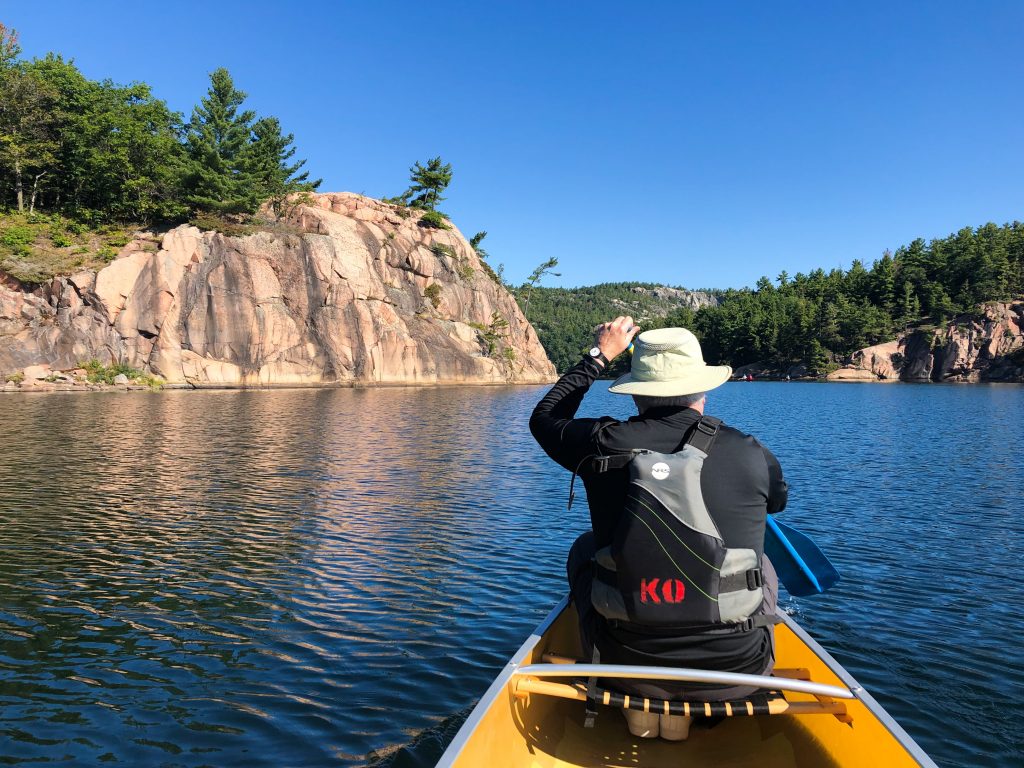
What to Wear While You’re Canoeing
I have a detailed post on what to wear canoeing, but here is the gist of it:
Quick Dry Pants and/or Shorts: I typically bring one pair of each. I have a pair of MEC hiking pants, but for shorts, I typically just use shorts you’d wear to the gym. Nothing fancy.
Quick Dry T-shirt: I’m still using the polyester quick-dry shirts I got in high school track and field tournaments a full 7 years later. Again, nothing fancy, it’ll get dirty anyway. A tank top works too, but I rarely paddle with anything but a T-shirt on because I get sunburned so easily. I’ve also started wearing this quick-dry anti-odour t-shirt and have found it nice.
Bathing Suit/Underwear & Sports Bra: Bathing suits are great if it’s hot and you want to go from a quick tip during the day, but some people prefer to just wear underwear and a sports bra (if applicable).
Wet Shoes: Whenever you think your feet might come in contact with water (while canoeing, when it’s raining) you wear your wet shoes. I prefer to use closed-toed trail running shoes so I can wear them during a portage or when walking through rapids too (for my last season canoe tripping I wore Salomon trail running shoes and loved them, however, the exact style has been discontinued). Some people prefer short hiking boots too.
Read This Next: Best Shoes for Canoeing: What to Look For and What to Buy
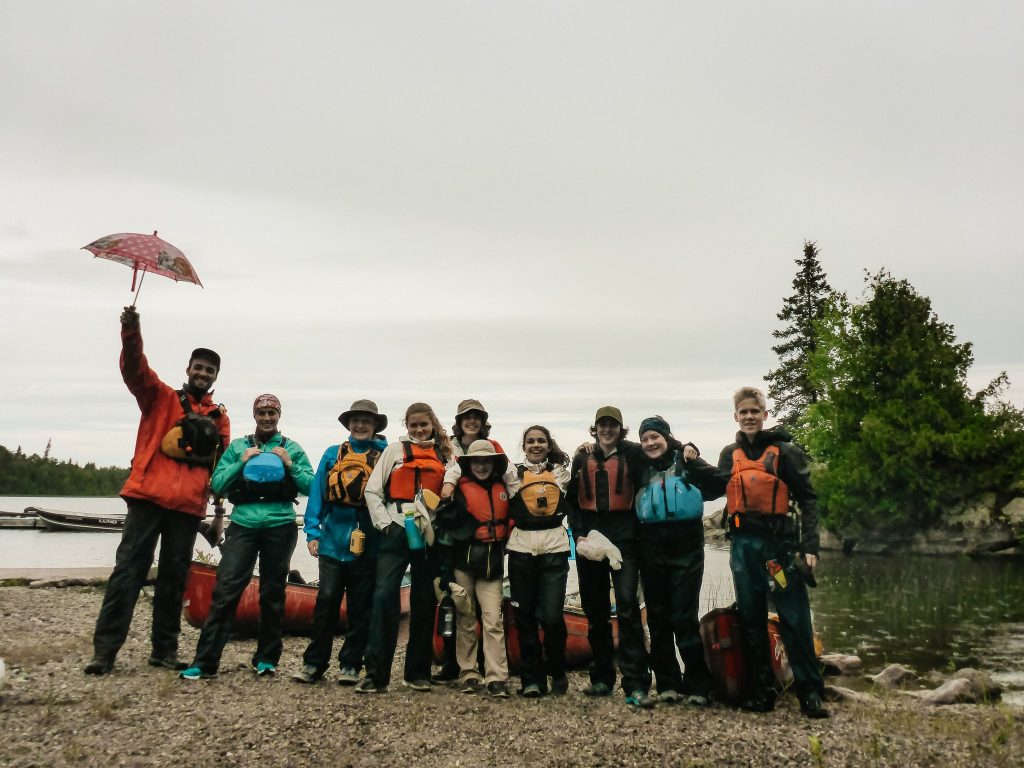
What to Have in the Canoe With You
Clear 10L dry sack: This is more a personal preference, but one of my favourite pieces of gear is a clear 10 L dry sack. Everything I might want during the day gets put in there. It keeps small things easy to access and quick to find, but it’ll also keep everything dry.
In the dry sack I pack (in roughly this order):
Toiletries: I keep my toothbrush, toothpaste and chapstick in here so I don’t lose them in my larger dry sack or barrel. Plus, I’ve usually packed up all of my stuff and loaded the canoes before I’ve eaten breakfast; having them here makes it easy. I don’t need it during the day so it goes at the bottom of the bag.
Fleece Long Sleeve Shirt: This again is more of a personal preference. I like to have a shirt handy if it’s windy or chilly on the water, and fleece dries relatively quickly if it were to get wet. I don’t take it out too often, so it’s near the bottom.
Rain Pants: If you’re going for a short trip, rain pants aren’t necessary but I strongly recommend having them. If it’s raining during the day you’ll stay much warmer if your legs are dry. Even at the site, you’ll stay so dry and be so much happier when you’re setting up your tent or cooking in the rain.
Sunscreen, bug cream, sunglasses, buff (if I’m not already wearing it), sunhat.
Disposable camera (or another type if you’re fancy).
Raincoat: Good quality raincoats need not be expensive. For a weekend in Algonquin, you don’t need a $400 Gore-Tex jacket; I’ve used a basic Patagonia Torrentshell (~$149) for three years now. It’s been used in the Canadian Arctic, on 20+ day river trips and short hiking trips in New Zealand, and still works great! I keep my raincoat at the top of the dry sack for quick access!
Update: I’ve since upgraded a lot of my camping gear, and you can read more about them in my post: My All-Time Favourite Camping Gear.
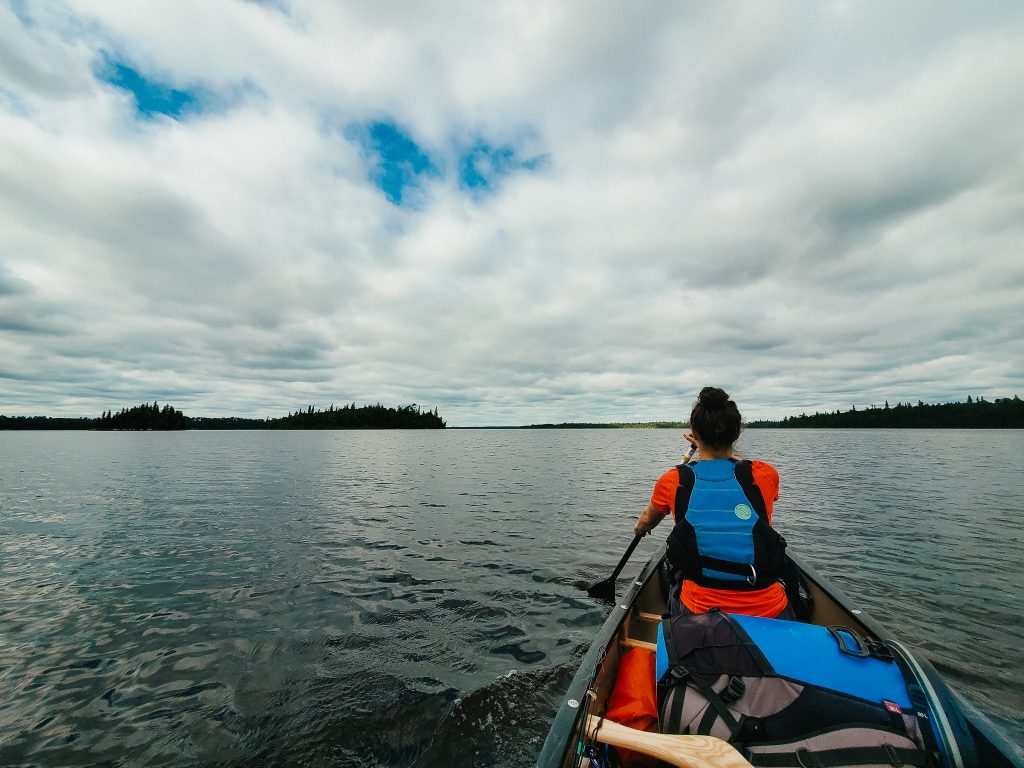
What to Wear At Your Campsite
Once my group has arrived at our campsite we all unload boats, and then some set up tents while others collect firewood. Once camp is in good shape, I change into my site clothing (weather permitting). With each canoe trip, you do you’ll learn more about what you like best. This is typically what I wear:
Dry Shoes: Tevas are popular because they dry quickly if you accidentally get them wet, they’re easy to put on and take off, and you can wear wool socks underneath.
Fleece and (Synthetic) Down: I like fleece because it’s warm and dries quickly, so I bring a pair of fleece pants and a fleece sweater. I got these Patagonia fleece pants on sale and I wear them almost every day now.
And the Patagonia Better Sweater is now in rotation with a youth large North Face long sleeve I got from a lost and found six years ago. I also have an Arc’teryx puffy down jacket I like to wear. However, I typically only wear it at the site because I don’t want it to get wet if I were to fall into the water.
Note: I’ve included links to my favourite gear which isn’t exactly inexpensive. Over the years I’ve slowly acquired a lot of high-quality clothing and equipment. But if you’re just getting started don’t stress about having fancy gear. Shop sales and thrift stores and rent if you need to. Finances should never force you indoors.
Long Underwear: For short and close trips, a pair of non-cotton tights and a non-cotton long sleeve are a great substitute for expensive long underwear. If you would like something a little more technical, long underwear (both pants and shirts) are either made of merino wool or synthetic material.
Merino wool is warmer and wicks away moisture better, but it’s also more expensive than synthetic. If you’re curious and want to splurge a little, this SmartWool shirt and these SmartWool pants are my favourite base layers I’ve ever owned.
Wool Socks: Warm feet are happy feet! Bring a few pairs. SmartWool is my favourite by far, but whatever brand you choose just please don’t make them cotton! Once they’re wet they’re wet forever.
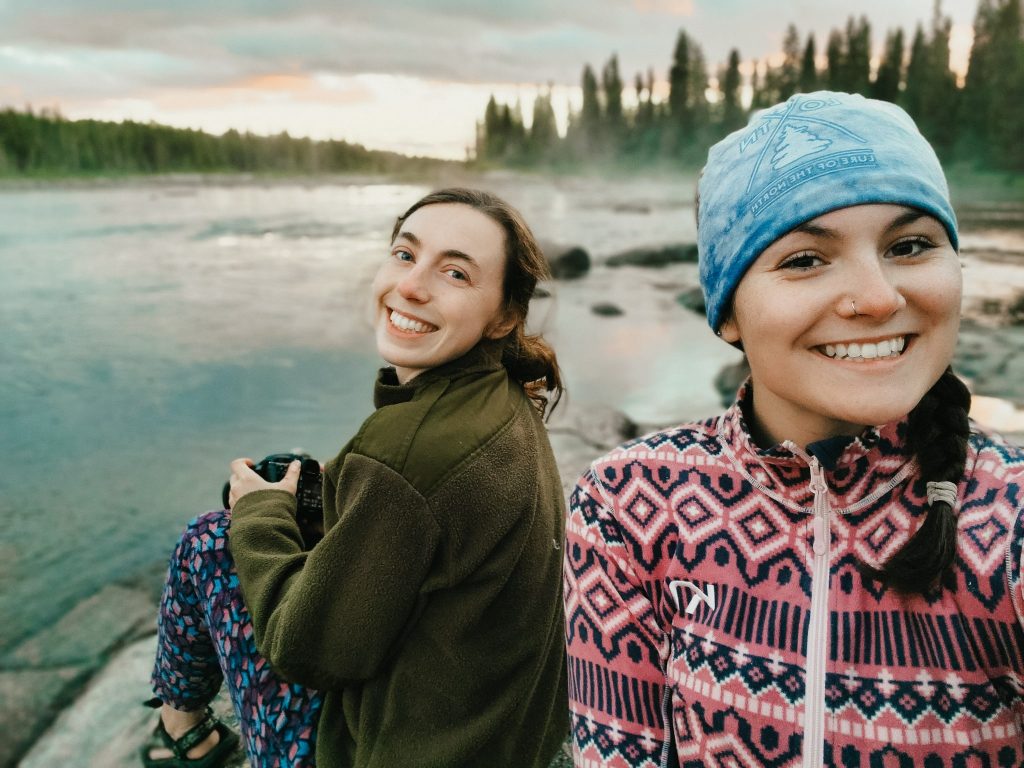
What Equipment to Pack
Your equipment pack carries all the hard wear you’ll need. This covers fire starting, water purification, cooking, shelter, etc.
Matches and lighters: I bring both. Keep them in a plastic bag to prevent them from getting wet. Pro tip: Keep some in the Equipment Pack, some in the First Aid Kit and some in your personal bag. That way if one bag gets wet, they don’t all get wet.
Cooking equipment: You will need a cooking stove and fuel canister (even if you plan on cooking over a fire). If it rains or there is a fire ban, you will need a stove. If you have room in your equipment pack, you can bring a small grill for over the fire.
Cooking utensils: Bring a pot with lid, frying pan, spatula, spoon, knife and fire glove for cooking. Bring bowls and spoons/forks for eating.
Clean Up: Bring steel wool or a scrubber and biodegradable camp soap to do dishes. Bring garbage bags to put any garbage in. Do not burn garbage. Pack it in, pack it out.
Poop Kit: Bring toilet paper and hand sanitizer. If you are going somewhere that doesn’t have thunder boxes, then bring a trowel. Read more: How to Poop in the Woods.
Water purification: You can either bring Aquatabs or a Water Pump (with Aquatabs as a backup).
Shelter: Tarp and rope. You could probably get away without these on shorter trips, but having a cooking shelter when it’s raining is a real game-changer.
Bonus: I like to carry some extra carabiners and zips ties because they’re handy.
Cooking & Food Packing
In this guide, I don’t go into detail on backcountry cooking and food prep for canoe trips, because I’ve written an entire cookbook on the topic.
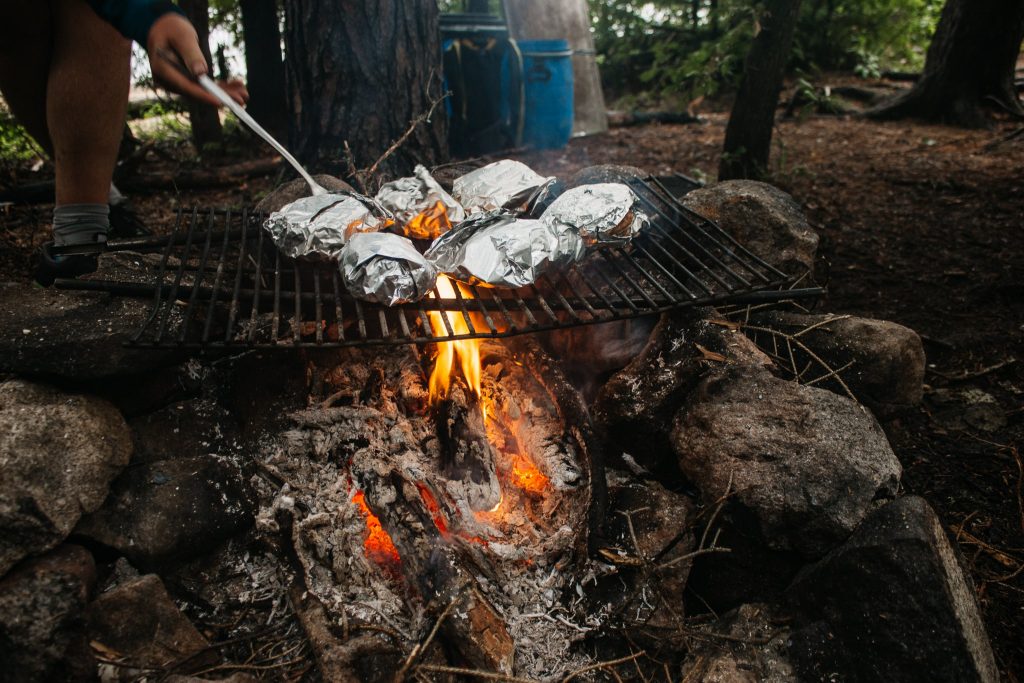
Sleeping Equipment
Tent: Obviously you’ll need a tent. The nice thing about canoeing (especially when you have short portages) is you don’t need to splurge on an ultralight tent. Store it in a dry sack so it stays dry throughout the day.
Sleeping pad and sleeping bag: Choose a three-season sleeping bag and sleeping pad. I also like bringing a compressible camping pillow (okay, maybe I’m a bit of a diva). If you’re worried about sleeping comfortably on trip, I have a whole post about strategies I’ve found to make sleeping in a tent better.
Pyjamas: I like to sleep in base layer pants/long sleeve shirt. I used to sleep in cotton pyjamas, but on one trip I found myself sweating a lot in the night. Since cotton takes forever to dry, my pyjamas stayed sweaty for the rest of the trip. Now I sleep in either wool or synthetic clothing.
Other Things to Bring
Here are some other items you can bring on your camping trip.
- Book, journal, pens, cards
- Headlamp and batteries
- Bug net
- Face wipes (I have a lot of tips for staying clean and fresh while camping)
- Compressible or blow-up pillow
- Hat and/or gloves if it’ll be cold
- Camera
Once you’re packed, you’re just about ready to go! Before you head out the door, always leave a copy of your route and when you’ll be back with someone from home. That way, if something were to go wrong, someone will know where you were supposed to be and it makes finding you much easier.
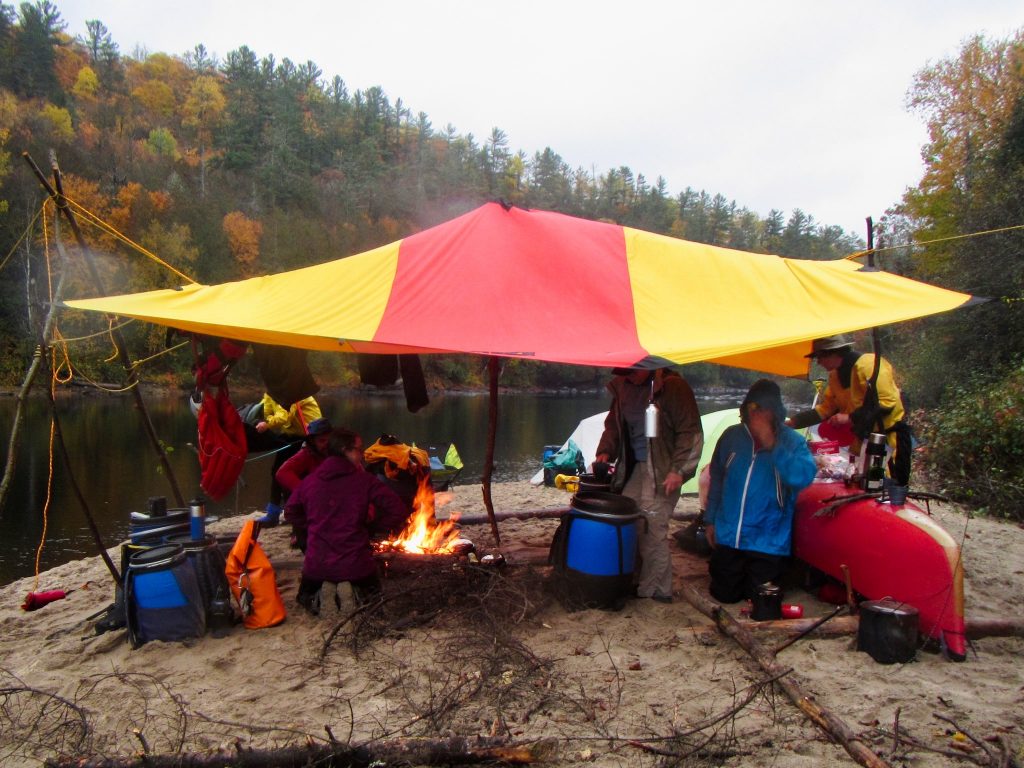
Getting to Your Canoe Camping Destination
In the majority of cases, you will drive to the destination you are paddling. At least in Canada, there isn’t much of a public transportation network for accessing provincial and national parks, plus you will have a lot of equipment, so I recommend driving yourself.
For a lot of beginner canoe routes, you will be able to park right at the put-in. The “put-in” is canoeist slang for “where you PUT IN the canoe to start the trip.” Since a lot of beginner canoe routes are loops, the put-in will also be the take-out, “where you TAKE OUT canoe at the end of the trip.”
At the put-in, you will be able to load your canoe, get ready with your lifejacket and paddle, and be ready to get on your way!
Taking Your First Canoe Camping Trip
So you’ve done the preparation and packing. You’ve picked up your equipment. But now you’re standing at the shoreline, paddle in one hand, map in the other, and thinking “oh my goodness, what have I gotten myself into?”
But then you remember that you’ve read this post and you know exactly what to expect on your first canoe camping trip.
Paddling
If you have no idea how to sit in a canoe or hold a paddle, do not fret. You will catch on quickly.
How do you hold a paddle? Please see an awkward photo of me below for reference. That is how you hold a paddle. In the photo, my left hand is gripping the butt of the canoe paddle and my right hand is holding the shaft.
Where do you sit in the canoe? The person in the bow (the front of the boat) is the powerhouse and lookout. Your responsibility is to look out for potential obstacles (a shallow rock or submerged log) and communicate that to the person in the back. That, and paddle. In the front, you only need to know the forward paddling stroke (though it doesn’t hurt to know how to draw – I’ll touch on this soon).
The person in the stern (back of the boat) is responsible for steering. You have three important paddling strokes to know. The forward stroke, the C-stroke and the J-stroke (though this one is kind of tricky so I’ll tell you a hack to avoid it).
In all honesty, reading a blog post about paddling strokes isn’t going to be particularly helpful. I recommend checking out YouTube videos on each of the strokes. (Wait, should I make paddling videos myself? Please comment below if you would watch me teach you how to paddle.)
Secret for the J-stroke: If you aren’t confident in your ability to do the J-stroke, what you can do instead is a pry stroke. After you do a forward stroke and the paddle is still in the water but pointed at the back of the canoe, push the water away from the back of the boat. This is called a pry and acts like a rutter (as on a sailboat or sea kayak). Check out this YouTube video on pry strokes.
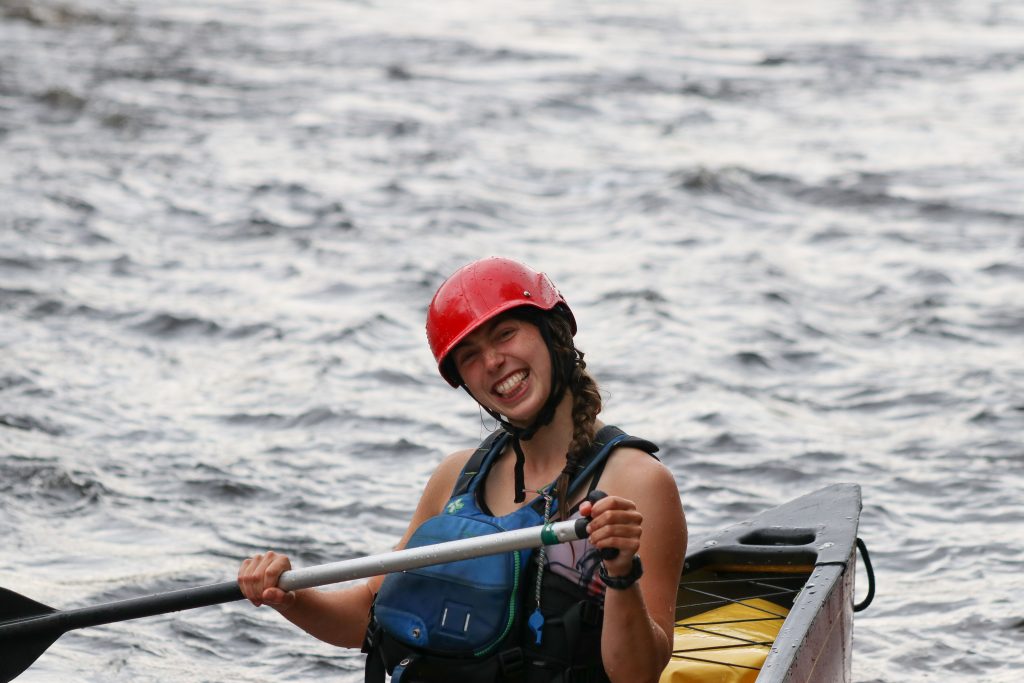
Navigation
This is the hardest thing about canoe camping, in my opinion. Especially in a park like Algonquin or Killarney where you have a ton of lakes and a ton of trees and it all looks, dare I say, identical?
First, you absolutely need to have recent and decent maps. You can purchase these at MEC or REI or at the outfitter directly. Store the bag in a waterproof map case or a ziplock bag to keep it dry.
Should you bring a compass? Yes, you should. I know it sounds annoying and what if you don’t know how to read a compass? Well, I’m sure there’s a YouTube video on compass reading and they aren’t too expensive. Now, do I always carry a compass with me? No, I do not and I’m sure a lot of my friends don’t either. If you prefer not to carry one that is your choice, but my official recommendation is that you should bring one.
Portaging
Ah, portaging. My least favourite part of canoe tripping. If you aren’t familiar, portaging takes place when you need to go from one lake to another or go around an obstacle in a river (like a waterfall). It involves hiking your gear from one side to another. Many people portage without having ever been taught how to do it – you pick it up quickly. Here are a few tips to make it easier for you (and some tips on portage etiquette):
- Easy portaging starts long before you hit the portage trail. When you back your boat, try to minimize the number of small, loose things you have to carry (i.e. tie water bottles and rain jackets to a backpack).
- Once you get to the portage, pull all your gear out of the water and out of the way. This will allow other people to use the portage too.
- Carry the canoe first because they are worse to carry.
- Carry the backpacks and barrels on the second trip. Load them directly into the canoes at the end of the portage.
If you want to learn more, I’ve written an entire post about how to portage (and a bunch of tips to make it easier).
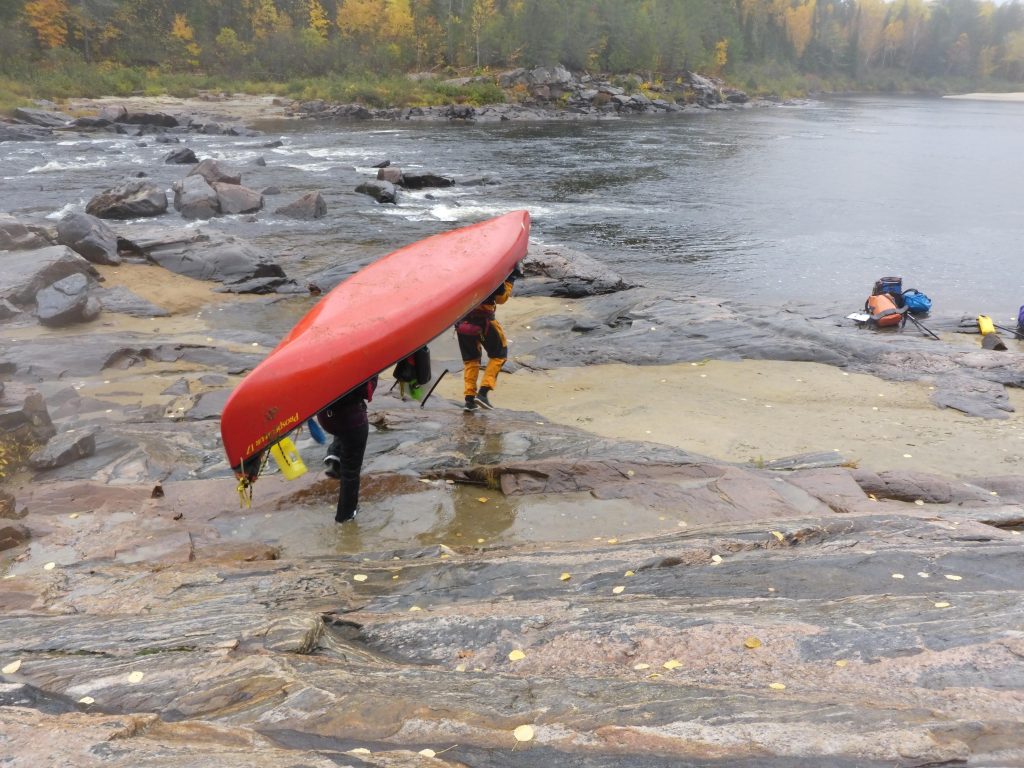
I hope this guide has inspired you to get out canoe camping, and given you the resources to do so safely. Any outstanding questions? Leave a comment below.
More Resources
Источник: https://www.voyageurtripper.com/guide-canoe-camping/
